Já editamos o arquivo “wp-config.php” inúmeras vezes ao configurar recursos avançados, corrigir problemas de conexão com o banco de dados ou facilitar o desenvolvimento local.
É um daqueles arquivos com os quais você acaba trabalhando sempre que precisa se aprofundar um pouco mais no funcionamento do WordPress. E quando você sabe onde procurar, é muito simples trabalhar com ele.
Esse arquivo controla algumas das configurações mais importantes do seu site, como acesso ao banco de dados, modo de depuração e chaves de segurança. É como o painel de controle oculto que faz com que seu site funcione sem problemas.
Neste guia, mostraremos como localizar e editar com segurança o arquivo `wp-config.php` usando diferentes ferramentas. Você poderá fazer as alterações necessárias sem se preocupar em quebrar nada.
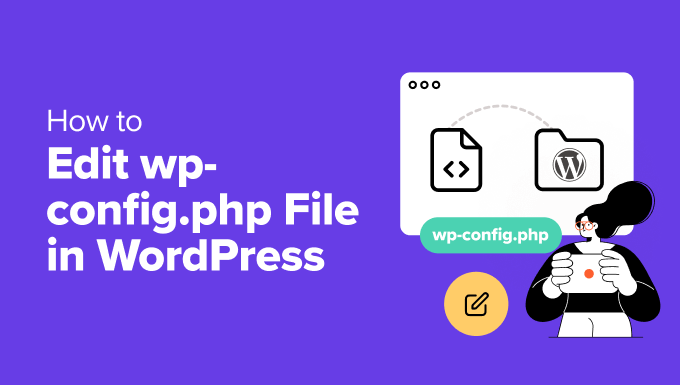
Aqui está uma lista dos tópicos que abordaremos neste guia:
- What Is the wp-config.php File?
- Create a Backup Before You Edit wp-config.php 💾
- How to Access and Edit the wp-config.php File Safely
- Understanding the wp-config.php File
- MySQL Settings in wp-config.php File
- Authentication Unique Keys and Salts
- WordPress Database Table Prefix
- WordPress Debugging Mode
- Absolute Path Settings
- Useful wp-config.php Hacks and Settings
- Changing MySQL Port and Sockets in WordPress
- Changing WordPress URLs Using wp-config.php File
- Changing Uploads Directory Using The wp-config.php File
- Disable Automatic Updates in WordPress
- Limit Post Revisions in WordPress
- Video Tutorial
- Next Steps to Power Up Your WordPress Skills
O que é o arquivo wp-config.php?
O arquivo `wp-config.php` é uma parte importante de todo site WordPress auto-hospedado. Ele contém configurações importantes que ajudam o WordPress a se conectar ao seu banco de dados e a funcionar sem problemas.
Esse arquivo não está incluído no download padrão do WordPress. Ele é criado automaticamente durante o processo de instalação, quando você insere os detalhes do banco de dados.
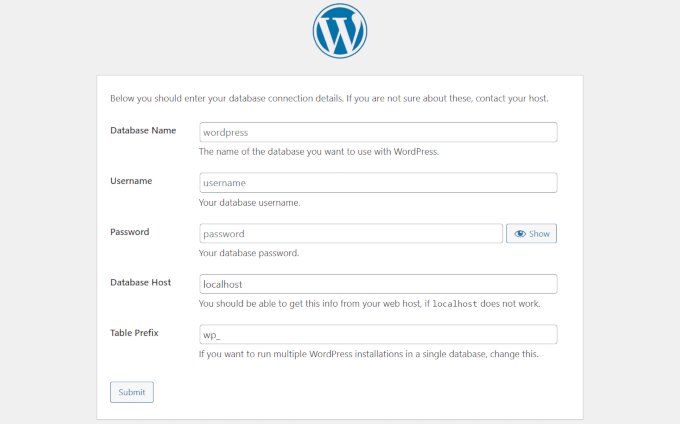
Sem as informações corretas nesse arquivo, seu site não conseguirá se conectar ao banco de dados. É nesse momento que você poderá ver a temida mensagem “erro ao estabelecer uma conexão com o banco de dados”.
Além dos detalhes do banco de dados, esse arquivo também pode incluir configurações para depuração, chaves de segurança, limites de memória e muito mais. Falaremos sobre isso mais adiante neste artigo.
A maioria das pessoas não precisa mexer no arquivo `wp-config.php` com muita frequência. Mas saber como ele funciona – e como editá-lo com segurança – lhe dá mais controle sobre o seu site WordPress.
Se você está aqui, provavelmente está pronto para fazer uma alteração. Vamos orientá-lo sobre a maneira mais segura de editar esse arquivo sem causar problemas.
💡 Não tem certeza de que quer arriscar quebrar seu site?
Se estiver se sentindo preso ou nervoso, aproveite nosso Suporte de Emergência para WordPress. Por uma pequena taxa, nossos engenheiros do WordPress aplicarão as alterações para você sem interromper seu site e seus clientes.
Crie um backup antes de editar o wp-config.php 💾
O arquivo `wp-config.php` controla partes importantes do seu site WordPress, e até mesmo um pequeno erro nele pode deixar seu site off-line.
É por isso que sempre recomendamos a criação de um backup completo do WordPress antes de fazer qualquer alteração.
Um backup mantém seu conteúdo, configurações e arquivos seguros e permite restaurar tudo se algo der errado.
A melhor maneira de fazer backup do WordPress é usar o Duplicator. Ele é a nossa solução preferida e o melhor plugin de backup do WordPress para a maioria dos usuários. Você pode fazer o backup do seu site com apenas alguns cliques.
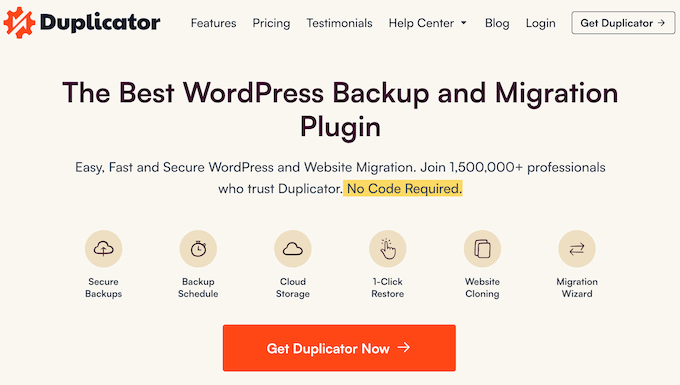
Observação: há também uma versão gratuita do Duplicator. Para obter recursos como backups programados e armazenamento em nuvem, recomendamos o plano pago.
Por que recomendamos o Duplicator?
Recomendamos o Duplicator porque o usamos em nossos próprios sites, incluindo o WPBeginner, para backups. Ele tem sido um divisor de águas para a segurança e a estabilidade de nossos sites. Para obter mais detalhes, dê uma olhada em nossa análise completa do Duplicator.
Como acessar e editar o arquivo wp-config.php com segurança
O arquivo `wp-config.php` fica no servidor de hospedagem do WordPress, na pasta raiz do seu site.
Você pode acessá-lo conectando-se ao seu site usando um cliente FTP ou o Gerenciador de arquivos no painel de controle da hospedagem.
Geralmente, preferimos o FTP para ter mais controle. No Windows, ferramentas como FileZilla, WinSCP ou SmartFTP funcionam bem. Os usuários de Mac podem experimentar o FileZilla, o Transmit ou o CyberDuck.
Comece conectando-se ao seu site usando o cliente FTP. Você precisará dos detalhes de login do FTP, que são fornecidos pela sua empresa de hospedagem. Caso não os conheça, basta perguntar à equipe de suporte do seu host.
Depois de conectado, abra a pasta raiz. Você verá outras pastas, como wp-content, wp-includes e wp-admin – é onde fica o `wp-config.php`.
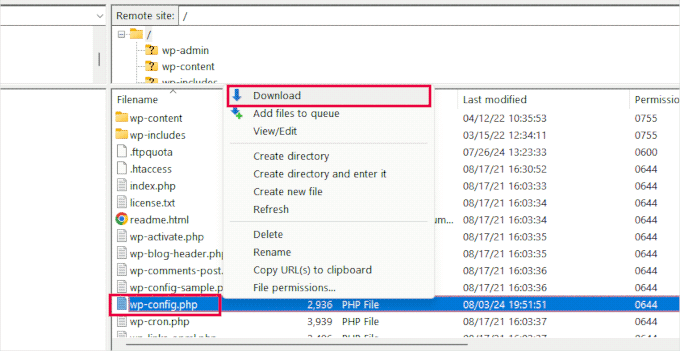
Clique com o botão direito do mouse no arquivo e escolha “Download” para salvá-lo em seu computador.
Em seguida, abra o arquivo usando um editor de texto simples, como o Notepad ou o TextEdit. Usamos os dois e eles funcionam muito bem para edições simples.
Depois de fazer as alterações, volte ao cliente FTP e carregue o arquivo na mesma pasta do servidor.
Seu cliente FTP perguntará se você deseja substituir o arquivo existente. Escolha “Overwrite” e clique em OK para concluir o upload.
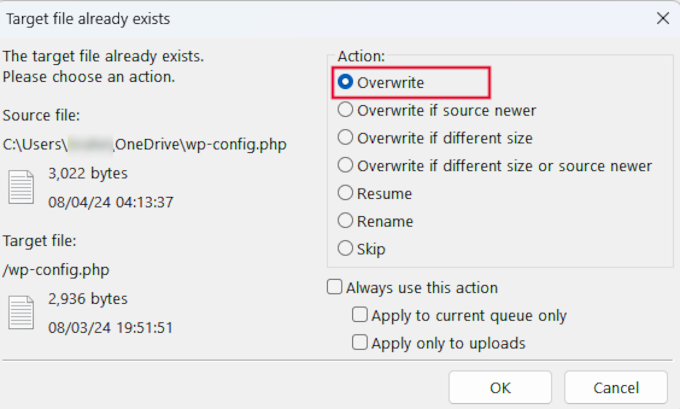
Entendendo o arquivo wp-config.php
Antes de começar, vamos examinar o código completo do arquivo wp-config.php padrão. Você também pode ver um exemplo desse arquivo aqui.
1 2 3 4 5 6 7 8 9 10 11 12 13 14 15 16 17 18 19 20 21 22 23 24 25 26 27 28 29 30 31 32 33 34 35 36 37 38 39 40 41 42 43 44 45 46 47 48 49 50 51 52 53 54 55 56 57 58 59 60 61 62 63 64 65 66 67 68 69 70 71 72 73 74 75 76 77 78 79 80 81 82 83 84 85 86 87 88 89 90 91 92 93 94 95 96 | <?php/** * The base configuration for WordPress * * The wp-config.php creation script uses this file during the installation. * You don't have to use the website, you can copy this file to "wp-config.php" * and fill in the values. * * This file contains the following configurations: * * * Database settings * * Secret keys * * Database table prefix * * ABSPATH * * @link https://developer.wordpress.org/advanced-administration/wordpress/wp-config/ * * @package WordPress */// ** Database settings - You can get this info from your web host ** ///** The name of the database for WordPress */define( 'DB_NAME', 'database_name_here' );/** Database username */define( 'DB_USER', 'username_here' );/** Database password */define( 'DB_PASSWORD', 'password_here' );/** Database hostname */define( 'DB_HOST', 'localhost' );/** Database charset to use in creating database tables. */define( 'DB_CHARSET', 'utf8' );/** The database collate type. Don't change this if in doubt. */define( 'DB_COLLATE', '' );/**#@+ * Authentication unique keys and salts. * * Change these to different unique phrases! You can generate these using * the {@link https://api.wordpress.org/secret-key/1.1/salt/ WordPress.org secret-key service}. * * You can change these at any point in time to invalidate all existing cookies. * This will force all users to have to log in again. * * @since 2.6.0 */define( 'AUTH_KEY', 'put your unique phrase here' );define( 'SECURE_AUTH_KEY', 'put your unique phrase here' );define( 'LOGGED_IN_KEY', 'put your unique phrase here' );define( 'NONCE_KEY', 'put your unique phrase here' );define( 'AUTH_SALT', 'put your unique phrase here' );define( 'SECURE_AUTH_SALT', 'put your unique phrase here' );define( 'LOGGED_IN_SALT', 'put your unique phrase here' );define( 'NONCE_SALT', 'put your unique phrase here' );/**#@-*//** * WordPress database table prefix. * * You can have multiple installations in one database if you give each * a unique prefix. Only numbers, letters, and underscores please! */$table_prefix = 'wp_';/** * For developers: WordPress debugging mode. * * Change this to true to enable the display of notices during development. * It is strongly recommended that plugin and theme developers use WP_DEBUG * in their development environments. * * For information on other constants that can be used for debugging, * visit the documentation. * * @link https://developer.wordpress.org/advanced-administration/debug/debug-wordpress/ */define( 'WP_DEBUG', false );/* Add any custom values between this line and the "stop editing" line. *//* That's all, stop editing! Happy publishing. *//** Absolute path to the WordPress directory. */if ( ! defined( 'ABSPATH' ) ) { define( 'ABSPATH', __DIR__ . '/' );}/** Sets up WordPress vars and included files. */require_once ABSPATH . 'wp-settings.php'; |
Cada seção do arquivo wp-config.php está bem documentada no próprio arquivo. Quase todas as configurações aqui são definidas usando constantes PHP.
1 | define( 'constant_name' , 'value'); |
Vamos dar uma olhada mais de perto em cada seção do arquivo wp-config.php.
Configurações do MySQL no arquivo wp-config.php
Suas configurações de conexão com o banco de dados do WordPress aparecem na seção “Database Settings” (Configurações do banco de dados) do arquivo wp-config.php.
Você precisará do host do MySQL, do nome do banco de dados, do nome de usuário do banco de dados e da senha para concluir esta seção.
1 2 3 4 5 6 7 8 9 10 11 12 13 14 15 16 17 18 | // ** Database settings - You can get this info from your web host ** ///** The name of the database for WordPress */define( 'DB_NAME', 'database_name_here' );/** Database username */define( 'DB_USER', 'username_here' );/** Database password */define( 'DB_PASSWORD', 'password_here' );/** Database hostname */define( 'DB_HOST', 'localhost' );/** Database charset to use in creating database tables. */define( 'DB_CHARSET', 'utf8' );/** The database collate type. Don't change this if in doubt. */define( 'DB_COLLATE', '' ); |
Aqui está uma lista das constantes nesta seção e o que elas fazem.
| Constant Name | Description |
|---|---|
| DB_NAME | The name of the database for WordPress. |
| DB_USER | The username used to access the WordPress database. |
| DB_PASSWORD | The password for the database username. |
| DB_HOST | The hostname of the database server (usually ‘localhost’). |
| DB_CHARSET | The hostname of the database server (usually ‘localhost’). |
| DB_COLLATE | The collation type for the database (usually left blank). |
Para preencher esses valores, você precisará das informações do banco de dados, que podem ser encontradas no painel de controle da sua conta de hospedagem na Web.
Dependendo do seu provedor de hospedagem, o painel de controle pode ter uma aparência ligeiramente diferente das capturas de tela abaixo. Nesse caso, você precisa procurar a seção “Databases” (Bancos de dados) na sua conta de hospedagem.
Por exemplo, se você estiver usando a Bluehost, primeiro faça login na sua conta de hospedagem. Em seguida, clique em “Settings” (Configurações) em seu site.
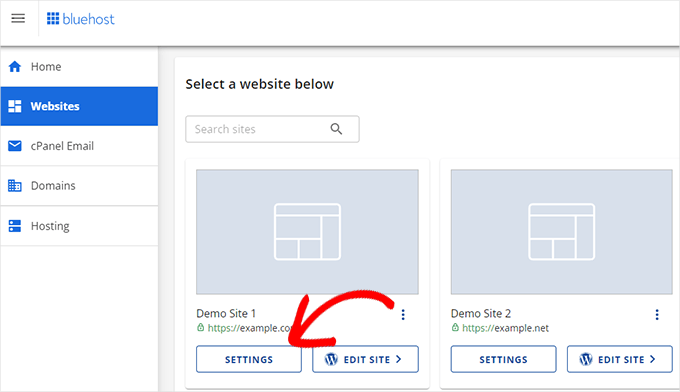
Isso mostrará diferentes configurações para seu site.
Vá para a guia Advanced (Avançado) e clique em “Manage” (Gerenciar) ao lado da seção “cPanel”.
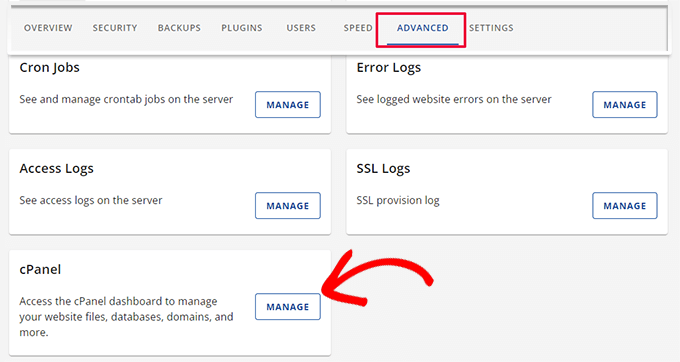
Isso abrirá a interface do cPanel em uma nova guia do navegador.
A partir daí, é necessário rolar até a seção Databases (Bancos de dados) e clicar em “MySQL Databases” (Bancos de dados MySQL).
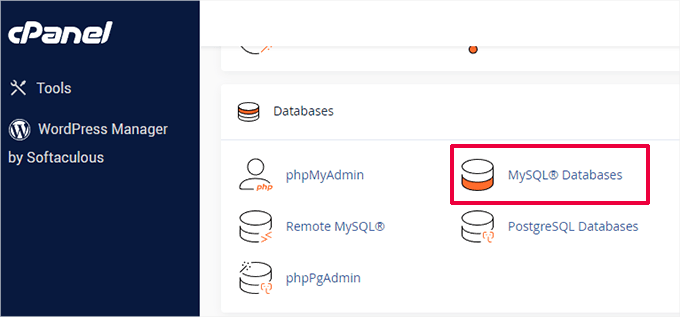
Na página MySQL Databases (Bancos de dados MySQL), você encontrará a lista do seu banco de dados atual, o nome de usuário e a senha.
Se não conseguir encontrar o banco de dados do WordPress ou o nome de usuário e a senha do MySQL, entre em contato com o host da Web.
O que são DB_CHARSET e DB_COLLATE no arquivo wp-config.php?
A configuração “DB_CHARSET” especifica o conjunto de caracteres para as tabelas do banco de dados do WordPress. O padrão é utf8, que suporta a maioria dos idiomas e garante ampla compatibilidade.
A configuração “DB_COLLATE” define como o banco de dados classifica e compara os caracteres.
Recomendamos deixá-lo em branco e permitir que o MySQL use o agrupamento padrão para o conjunto de caracteres especificado (utf8_general_ci para utf8).
Chaves e sais exclusivos de autenticação
Chaves e sais de autenticação são recursos de segurança no arquivo wp-config.php. Eles adicionam proteção extra à sua instalação do WordPress, garantindo a criptografia forte das informações armazenadas nos cookies do usuário.
1 2 3 4 5 6 7 8 9 10 11 12 13 14 15 16 17 18 19 20 21 | /**#@+ * Authentication unique keys and salts. * * Change these to different unique phrases! You can generate these using * the {@link https://api.wordpress.org/secret-key/1.1/salt/ WordPress.org secret-key service}. * * You can change these at any point in time to invalidate all existing cookies. * This will force all users to have to log in again. * * @since 2.6.0 */define( 'AUTH_KEY', 'put your unique phrase here' );define( 'SECURE_AUTH_KEY', 'put your unique phrase here' );define( 'LOGGED_IN_KEY', 'put your unique phrase here' );define( 'NONCE_KEY', 'put your unique phrase here' );define( 'AUTH_SALT', 'put your unique phrase here' );define( 'SECURE_AUTH_SALT', 'put your unique phrase here' );define( 'LOGGED_IN_SALT', 'put your unique phrase here' );define( 'NONCE_SALT', 'put your unique phrase here' );/**#@-*/ |
Há oito chaves e sais diferentes no total. Cada par de chave e sal é uma sequência longa e aleatória de números de texto e caracteres especiais.
Veja a seguir o que cada tecla faz:
| Constant Name | Description |
|---|---|
| AUTH_KEY | Authenticate cookies and ensure data integrity. |
| SECURE_AUTH_KEY | Secure the authentication cookie when using SSL. |
| LOGGED_IN_KEY | Validate logged-in cookies. |
| NONCE_KEY | Protect nonces (numbers used once) from being guessed. |
| AUTH_SALT | Adds extra security to the authentication process. |
| SECURE_AUTH_SALT | Adds extra security to the authentication process. |
| LOGGED_IN_SALT | Adds extra security to the logged-in process. |
| NONCE_SALT | Adds extra security to the nonce creation and verification process. |
Você pode gerar novas chaves visitando o gerador de chaves secretas do WordPress.org. Você também pode alterá-las posteriormente se suspeitar que alguém está tentando acessar a área de administração do WordPress.
Para obter mais informações, dê uma olhada em nosso guia sobre chaves de segurança do WordPress.
Prefixo da tabela do banco de dados do WordPress
Por padrão, o WordPress adiciona o prefixo “wp_” a todas as tabelas que cria no banco de dados.
Recomenda-se que você altere o prefixo da tabela do banco de dados do WordPress para algo aleatório durante a instalação.
Isso dificultará que os hackers adivinhem suas tabelas do WordPress e o salvará de alguns ataques comuns de injeção de SQL.
1 2 3 4 5 6 7 | /** * WordPress database table prefix. * * You can have multiple installations in one database if you give each * a unique prefix. Only numbers, letters, and underscores please! */$table_prefix = 'wp_'; |
Importante ⚠️: Observe que você não pode alterar esse valor em um site existente do WordPress. Para alterar essas configurações em um site existente do WordPress, siga as instruções em nosso artigo sobre como alterar o prefixo do banco de dados do WordPress.
Modo de depuração do WordPress
Essa configuração é particularmente útil para usuários que estão aprendendo a desenvolver o WordPress ou a solucionar erros.
Por padrão, o WordPress oculta os avisos gerados pelo PHP durante a execução do código. Basta definir o modo de depuração como “true” para mostrar esses avisos.
Isso fornece informações cruciais para que os desenvolvedores encontrem bugs. Também ajudará se você estiver tentando solucionar problemas em um site WordPress.
1 2 3 4 5 6 7 8 9 10 11 12 13 | /** * For developers: WordPress debugging mode. * * Change this to true to enable the display of notices during development. * It is strongly recommended that plugin and theme developers use WP_DEBUG * in their development environments. * * For information on other constants that can be used for debugging, * visit the documentation. * * @link https://developer.wordpress.org/advanced-administration/debug/debug-wordpress/ */define( 'WP_DEBUG', false ); |
Como alternativa, você também pode optar por manter um registro de erros e avisos.
Para obter instruções mais detalhadas, confira nosso tutorial sobre como ativar o modo de depuração no WordPress.
Configurações de caminho absoluto
A última parte do arquivo wp-config define o caminho absoluto. Essa instrução informa ao WordPress onde encontrar os arquivos principais do WordPress.
Após essa instrução, o ABSPATH é usado para carregar o arquivo wp-settings.php.
1 2 3 4 5 6 7 | /** Absolute path to the WordPress directory. */if ( ! defined( 'ABSPATH' ) ) { define( 'ABSPATH', __DIR__ . '/' );}/** Sets up WordPress vars and included files. */require_once ABSPATH . 'wp-settings.php'; |
Essas duas configurações não devem ser alteradas.
Para entender como o WordPress carrega arquivos, dê uma olhada em nosso explicador sobre como o WordPress funciona nos bastidores. Ele lhe dará um detalhamento passo a passo de como funciona o software principal do WordPress.
Hacks e configurações úteis do wp-config.php
Até agora, abordamos as configurações padrão do wp-config.php. Agora, vamos examinar algumas configurações adicionais.
Essas configurações são opcionais e podem ser usadas quando necessário. Elas podem ajudá-lo a solucionar erros e resolver muitos erros comuns do WordPress.
Como alterar a porta e os soquetes do MySQL no WordPress
Se o seu provedor de hospedagem WordPress usar portas alternativas para o host MySQL, será necessário alterar o valor DB_HOST para incluir o número da porta.
Observação: Essa não é uma nova linha, mas você deve editar o valor DB_HOST existente.
1 | define( 'DB_HOST', 'localhost:5067' ); |
Não se esqueça de alterar o número da porta 5067 para qualquer número de porta fornecido pelo seu host da Web.
Se o seu host usar soquetes e pipes para o MySQL, você precisará adicioná-lo da seguinte forma:
1 | define( 'DB_HOST', 'localhost:/var/run/mysqld/mysqld.sock' ); |
Alteração de URLs do WordPress usando o arquivo wp-config.php
Talvez seja necessário alterar os URLs do WordPress ao mover um site do WordPress para um novo nome de domínio.
Você pode alterar esses URLs visitando a página Configurações ” Geral.
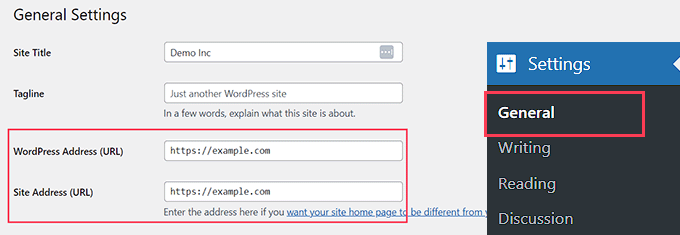
Você também pode alterar esses URLs usando o arquivo wp-config.php. Isso é útil se você não conseguir acessar a área de administração do WordPress devido ao problema de erro de muitos direcionamentos.
Basta adicionar essas duas linhas ao seu arquivo wp-config.php:
1 2 | define('WP_HOME','http://example.com');define('WP_SITEURL','http://example.com'); |
Não se esqueça de substituir example.com pelo seu nome de domínio.
Você também precisa ter em mente que os mecanismos de pesquisa tratam www.example.com e example.com como dois locais diferentes (consulte www vs non-www – Qual é o melhor para SEO?).
Se o seu site for indexado com um prefixo www, você precisará adicionar o nome de domínio de acordo.
Alteração do diretório de uploads usando o arquivo wp-config.php
Por padrão, o WordPress armazena todos os seus uploads de mídia no diretório/wp-content/uploads/.
Se quiser armazenar seus arquivos de mídia em um local diferente, adicione esta linha de código no arquivo wp-config.php:
1 | define( 'UPLOADS', 'wp-content/media' ); |
Observe que o caminho do diretório de uploads é relativo ao ABSPATH definido automaticamente no WordPress. A adição de um caminho absoluto aqui não funcionará.
Consulte nosso guia detalhado sobre como alterar o local padrão de upload de mídia no WordPress para obter mais informações.
Desativar atualizações automáticas no WordPress
O WordPress tem as atualizações automáticas ativadas por padrão. Isso permite que os sites do WordPress sejam atualizados automaticamente quando uma pequena atualização estiver disponível.
Por exemplo, se o seu site estiver executando o WordPress 6.6 e uma atualização de segurança 6.6.1 for lançada, o WordPress instalará automaticamente a atualização.
No entanto, quando o WordPress 6.7 for lançado, você será solicitado a iniciar a atualização.
Embora as atualizações automáticas sejam essenciais para a segurança, muitos usuários temem que elas também possam danificar o site, tornando-o inacessível.
Adicionar essa única linha de código ao seu arquivo wp-config.php desativará todas as atualizações automáticas em seu site WordPress:
1 | define( 'WP_AUTO_UPDATE_CORE', false ); |
Consulte nosso tutorial sobre como desativar as atualizações automáticas no WordPress para obter mais informações.
Limitar revisões de postagens no WordPress
O WordPress vem com salvamento automático e revisões incorporadas. Consulte nosso tutorial sobre como desfazer alterações no WordPress com revisões de postagens.
As revisões ocupam pouco espaço na maioria dos sites. No entanto, notamos um aumento significativo no tamanho do backup do banco de dados em alguns de nossos sites maiores.
Se você administra um site grande, pode limitar o número de revisões que deseja manter no banco de dados.
Basta adicionar esta linha de código ao seu arquivo wp-config.php para limitar o número de revisões armazenadas para uma postagem:
1 | define( 'WP_POST_REVISIONS', 3 ); |
Substitua 3 pelo número de revisões que você deseja armazenar.
O WordPress agora descartará automaticamente as revisões mais antigas. No entanto, as revisões de postagens mais antigas ainda estão armazenadas em seu banco de dados. Consulte nosso tutorial sobre como excluir revisões de postagens antigas no WordPress.
Tutorial em vídeo
Se você também quiser ver um passo a passo mais visual, confira nosso tutorial no YouTube abaixo:
Próximas etapas para aprimorar suas habilidades com o WordPress
Agora que você sabe como editar o arquivo `wp-config.php`, talvez esteja curioso para saber o que mais pode ser ajustado para tornar seu site ainda melhor. Reunimos alguns de nossos tutoriais favoritos para ajudá-lo a continuar explorando e aprimorando suas habilidades.
Cada um deles aborda dicas práticas que nós mesmos usamos ao gerenciar sites WordPress:
- Como configurar os registros de erros do WordPress no WP-Config
- Dicas, truques e hacks do WordPress mais procurados
- Truques .htaccess mais úteis para WordPress
- Atalhos de teclado do WordPress mais úteis para economizar tempo
Esperamos que este artigo tenha ajudado você a aprender como editar o arquivo wp-config.php no WordPress e todas as coisas legais que você pode fazer com ele. Talvez você também queira ver nosso artigo sobre como proteger o diretório de administração do WordPress com senha ou nossas dicas para usar a barra de administração do WordPress.
Se você gostou deste artigo, inscreva-se em nosso canal do YouTube para receber tutoriais em vídeo sobre o WordPress. Você também pode nos encontrar no Twitter e no Facebook.





Sean Hodge
I believe you should not put any custom rules below the ABSPATH / vars bit down at the bottom, but can you put stuff in any order above those lines?
I’ve got some time on my hands, so I’ve been doing just that, moving stuff around the wp-config file, and removing all the extra fluff between comments. I now know what it all does, and have just left a simple title above each group of rules, such as
/**
* Authentication Unique Keys and Salts.
*/
All the rest of the info about Salts, and debugging etc, is now gone, the stuff that usually appears in green.
What I also did was move the $table_prefix above the Salts, right under the rest of the database info.
I’ve done this all because when I do go in there to modify actual rules, I have to wade my way through what is now useless info, to me.
So far, nothing has exploded, but I thought to ask anyway.
WPBeginner Support
You can change the order of the other content in that file if you wanted, we would warn to be careful when moving that you don’t remove part of the code and normally you should not need to edit your wp-config file.
Admin
Priyanshu Nandi
Which code lines l have to type to increase
Max_input_vars value in this file
WPBeginner Support
That would require changes to your htaccess or a different file, we would recommend reaching out to your host for assistance with what you’re wanting to do.
Admin
WPBeginner Support
Thank you, glad you liked our article
Admin
S.s. Brar
Great article. A must have information for WP admins.
Thanks to Syed and His Team.
WPBeginner Support
Glad our article could be helpful
Admin
Mister No
Hi there, great article. I’m having a problem with my website mobile version. When I try to open it on the mobile phone it says “This site is experiencing technical difficulties”.
What should I do to make my site work again properly?
Thanks in advance
WPBeginner Support
There are a few possible reasons you could be receiving that error, for a starting point you would want to take a look at our guide here: https://www.wpbeginner.com/beginners-guide/beginners-guide-to-troubleshooting-wordpress-errors-step-by-step/
Admin
Paul
Syed, all of a sudden, I can’t upload images (message: missing a temporary folder). Tried to log into WordPress to check support blogs and my username is not recognised.
WPBeginner Support
For that error, you would want to take a look at our guide here: https://www.wpbeginner.com/wp-tutorials/how-to-fix-missing-a-temporary-folder-error-in-wordpress/
Admin
Gale
I am a newbie at wordpress. I uploaded the files via Filezilla and got everything configured. Now how exactly do I actually access my new wp-blog site?
Wp is in the root (public_html) of my website. There were several other file folders that came with Wp. Do I upload them into the public_html folder as well?
WPBeginner Support
If you’re installing WordPress using FTP then you would want to take a look at our guide here:
https://www.wpbeginner.com/how-to-install-wordpress/#installftp
Once the site is set up you would want to go to your login page and log in with the user you created in the installation process:
https://www.wpbeginner.com/beginners-guide/how-to-find-your-wordpress-login-url/
Admin
Esther
Hi, I found out when I was installing WordPress, it was installed in subdirectory Wp and has a result my website can’t go live, my web host said I have to uninstall and install again and I should leave the Wp in the Installation panel blank, my problem is that I have designed the website only to go live and once I uninstall everything will be wiped off, what do I about it, Is there a way to avoid that?
WPBeginner Support
If your host requires the site to be in the main directory, you would want to follow the steps in the WordPress coded to move directories on your existing server
Admin
Mina
Hi,
Thank you for the useful article.
I’m new to this file and I have a basic question. I changed the cache plugin of my site and I need to change the line about it at the beginning of the file to override details of the previous plugin.
Once my file is updated, can I upload it while the cache plugin is activated, and deactivate/reactivate it just after, or do I have to deactivate the plugin before uploading the new wp-config file ?
Thanks for your help.
WPBeginner Support
If your plugin is requiring you to edit your wp-config file you would normally want to edit the wp-config file before activating your new plugin.
Admin
Tiar
hi, i have a wordpress site, i want edit my wordpress site in local, but when i already backup and run my wordpress in local. the page is full of white. can you help me ? im beginner in wordpress
WPBeginner Support
For moving your live site to a local installation, you would want to use the guide here: https://www.wpbeginner.com/wp-tutorials/how-to-move-live-wordpress-site-to-local-server/
Admin
Arthur
I have updated my website (lostkatanning.com) o WP 5.1 (the Gutenberg update) but now, when working on pages or posts it has slowed right down to a crawl and takes forever to respond to even a single key touch. I have tried numerous things from various websites but nothing seems to work. It is starting to do my head in! Any ideas on how to get my speed back?
WPBeginner Support
Hi Arthur,
You can disable the Gutenberg by installing the classic editor plugin to temporarily solve the problem.
Admin
mostafa
Hi
I have a wordpress site. Today I realized my wp-config.php file has been removed for no reason (The reason is not important for me right now).
I want to know what happens if I create another wp-config.php file in the root directory of my website by renaming the wp-config-sample.php file again and set the database name blah blah blah
does it affect my pages and posts? How about the users who have signed up to my website? does it remove them? If the answer is yes, isn’t it better for me to restore backup? The only problem for restoring backup is that it is for two days ago and I posted a new content yesterday and I will miss it.
Thank you very much in advance
WPBeginner Support
Your user and post information is in the database so that information shouldn’t be affected, as long as you connect it to your correct database then there shouldn’t be any change.
Admin
Deepak
Hello,
How do I edit wp-config for setting other smtp using WP smtp plugin ?
Plugin says, “The password is stored in plain text. We highly recommend you setup your password in your WordPress configuration file for improved security; to do this add the lines below to your wp-config.phpfile.
define( ‘WPMS_ON’, true ); define( ‘WPMS_SMTP_PASS’, ‘your_password’ ); ”
Where do I exactly add the code ? It don’t shown in tutorial video or article of Wpbeginner.
WPBeginner Support
Hi Deepak,
You can add this code just before the line that says ‘That’s all, stop editing! Happy blogging’ in your wp-config.php file.
Admin
Riyaz
Thank you for sharing this article, it was simple and easy to understand.
Gaurav Bhatnagar
Hi, I just updated my WordPress to new version manually using FileZilla. My website was working. But then, I did some update inside wp-config.php file. Now the size of that file on server has become ‘0’. Even if I update it from local PC, it still remains ‘0’. What should I do? Now website is not working. I am getting – HTTP Error 500
WPBeginner Support
Hi Gaurav,
You can download a fresh copy of WordPress and extract it on your computer. Inside it you will find a wp-config-sample.php file. You can upload this file to your server and rename it to wp-config.php. You will now need to edit wp-config.php file and enter your WordPress database information.
Admin
Gaurav Bhatnagar
It worked. Thank you.
Greg Bryant
I have an intranet-based wordpress site that I’m setting up. I’m having issues with the proxy configuration in wp-config.php. I’ve tried about everything I know and I still keep getting ‘Proxy Authentication Required” errors.
define(‘WP_PROXY_HOST’, ‘https://proxy.domain.com’);
define(‘WP_PROXY_PORT’, ‘3128’);
define(‘WP_PROXY_USERNAME’, ‘domain\\username’);
define(‘WP_PROXY_PASSWORD’, ‘xxxxxx’);
define(‘WP_PROXY_BYPASS_HOSTS’, ‘localhost’);
Our internal wordpress site can detect that there are new versions of plug-ins but when I try to update I get the proxy authentication error. I’ve tried the variables above with https, http, just proxy.domain.com, the username escaping the \, not escaping the backslash, etc. I looked at the code in class-wp-http-proxy.php and it appears the authentication connects the username with a : and then the password like the http(s)_proxy environment variable. I’ve tried local host for the bypass and an empty string. Our Windows domain uses an file; is there a place to specify this?
I get the same proxy authentication errors trying to download anything from the internal wordpress site.
Error occurred. Something may be wrong with WordPress.org or this server’s configuration. If you continue to have problems, please try the support forums. (WordPress could not establish a secure connection to WordPress.org. Please contact your server administrator.) in /var/www/epkb.mw-process-ctrl.com/public_html/wp-admin/includes/plugin-install.php on line 168
I’m also having an issue with php’s file_get_contents if that’s something wordpress uses. cURL works fine.
Any ideas?
Thanks
WPBeginner Support
Hi Greg,
Please make sure that your localhost environment has curl extension installed and enabled for PHP. Please see our guide on how to fix secure connection error in WordPress for more details.
Admin
Greg Bryant
I have curl installed.
It lists ipV6 as yes but I have ipV6 disabled since our network doesn’t support it.
I think the problem is authenticating with our proxy. On the server I use:
(the \ is escaped when setting the env variables). Above is my wp-content proxy settings.
I’m using ufw for my firewall and have tried with it enabled & disabled with the same results.
Any other ideas?
Thanks
WPBeginner Support
Hi Greg,
We are not sure. You can post on WordPress.org forums may be someone who has faced similar situation can help out.
Jon M
Do the changes take effect immediately after saving the new wp-config file?
WPBeginner Support
Hey Jon,
Yes, they are effectively immediately. However, if you are editing wp-config file in a text editor on your computer, then simply saving your changes may not change the wp-config.php file on your server. You will need to upload the changed wp-config.php file back to your server for changes to take effect.
Admin
Andy
What’s the best way to upload the changed wp-config.php file back to the server?
Can the tutorial be updated with how to upload the adjusted config file? The tutorial seems to be incomplete for the (relative) novice
WPBeginner Support
Hi Andy,
We have linked to our article on how to use FTP to upload WordPress files. It also applies to editing your wp-config.php file. You can simply download your wp-config.php file to your computer using FTP. Edit it to make your desired changes and then upload it back using the same FTP client.
Hope this helps.
ayush
I did something silly , i removed the www part from wp site url under Setting-General . Now admin panel is getting redirected to wordpress one. i used your steps to copy both lines with modification and uploaded via ftp . No luck .Plz help
Boris
Excellent post. I am a newbie and learned a lot.
I have an issue with my site. It looks like I have been hacked. I ran WordFence scan and it caught a line of code in my wp-config.php file that it flagged as not belonging there. Following is the code:
My question is this. Can I remove the "@include…" from the file without screwing up the .php file.
Any guidance will be appreciated.
WPBeginner Support
Hi Boris,
Is the file part of the core WordPress software, a plugin, or a theme? If yes, then download a fresh copy of WordPress core, plugins, or theme the file belongs to and then upload the new file.
You can also download the file to your computer before editing the code as a backup. If anything goes wrong you can then upload it back.
Admin
Saud Razzak
Great post, glad I read.
Steph
I’m having problems accessing site. I debugged and am getting a list of problems but most seem to come back to this one:
“Notice: get_settings is deprecated since version 2.1.0!
Use get_option() instead. in /usr/local/pem/vhosts/xxxxxx/webspace/siteapps/WordPress-xxxxx/htdocs/wp-includes/functions.php on line 3752″
But line 3752 reads:
” trigger_error( sprintf( __(‘%1$s is deprecated since version %2$s! Use %3$s instead.’), $function, $version, $replacement ) ); ”
So i’ve no idea what to replace. I’m sure this is 101 stuff to you, but I’m really confused!! I would really appreciate your advice, thank you.
Steph
Found your section on disabling plugins – which was a great help as the the site is now viewable whilst I try to resolve. This is the message I see now when logged in WP Admin
” Catchable fatal error: Argument 1 passed to Genesis_Admin_CPT_Archive_Settings::__construct() must be an instance of stdClass, instance of WP_Post_Type given, called in /usr/local/pem/vhosts/xxxxxx/webspace/siteapps/WordPress-xxxxxx/htdocs/wp-content/themes/genesis/lib/admin/menu.php on line 122 and defined in /usr/local/pem/vhosts/xxxxxx/webspace/siteapps/WordPress-xxxxxx/htdocs/wp-content/themes/genesis/lib/admin/cpt-archive-settings.php on line 38 ”
Am in a spot of bother and could really use your help – thank you!
WPBeginner Support
Hey Steph,
Try updating your Genesis child theme. Connect to your website using FTP and download your child theme as a backup. After that delete child theme folder from your website.
Next, download a fresh copy of the theme and install it. If this doesn’t work, then try updating Genesis core itself.
Admin
Hell Men
If i delete salt key can i decrypt wordpress password ?
Sean
Hi,
I did something silly and now can’t get my site to work. Basically I kept my site live at said URL example.com and created a folder where I built the WordPress site example.com/Wordpress. However when I went to put the wordpress site into the root folder after backing everything up I forgot to change the site URL in the dashboard. i basically then removed my entire site and copied everything from the wordpress site into the root URL. It didn’t work – so I thought I would remove everything and restore my site as it was with both the wordpress and the normal site working.
However once I restored all the files the wordpress site now errors with 404 Page not found and I can’t login into the dashboard either.
Any idea how I can restore this? I think it is looking in the root directory and WordPress folder for the site or something similar and it’s causing the error – but how do I fix it?
Thanks
Sean
WPBeginner Support
Hi Sean,
You can update WordPress URLs by adding this code to your wp-config.php file:
define('WP_HOME','http://example.com');define('WP_SITEURL','http://example.com');
Admin
Dan
Hello i would like to have it when i upload an image it gets uploaded to my cloud from wordpress.
i got a url & api key.
Any suggestions would be cool. thanks.
Eeswar Reddy
Best site for WordPress Beginners. Solved my blog problem simply. Thank u so much Sir…
WPBeginner Support
You are welcome Don’t forget to join us on Twitter for more WordPress tips and tutorials.
Don’t forget to join us on Twitter for more WordPress tips and tutorials.
Admin
Karl
Nice instructions, as far as they go. However, I know it is ALSO possible to edit wp-config.php directly through WordPress’ Admin area but it seems to be a closely guarded secret as to HOW to actually do this. I do not have FTP access to my site so I have to use some other method and I’d rather not go chasing down the rabbit hole of trying out various flaky plugins until I find one that actually works. Your assistance as to what menu drill-down to explore in WordPress Admin would be greatly appreciated.
WPBeginner Support
It is not a good idea to edit wp-config.php file inside WordPress admin area. One tiny mistake and you will be locked out of your WordPress site. If you do not have FTP access, you can try editing it via cPanel’s file manager.
Admin
Angela
I don’t want to sound stupid, but please help me understand… are the wp-config.php changes supposed to be made on my Mac or on the host for my website. They are two different machines.
Please help! I keep making changes to my web site and all of a sudden they just do not ‘take’.
Best regards,
Angela
WPBeginner Support
You can make changes to wp-config.php file using an FTP client. It allows you to edit files on your web server. After connecting to your website using an FTP client, you need to locate wp-config.php file and download it to your computer. Make changes it to it using a text editor like TextEdit. Save your changes and then upload the file back to your web server using the FTP client.
Admin
Sharron
Ok, so I added define(‘WP_ALLOW_REPAIR’, true); to my downloaded wp config file with notepad. Now what?
Ray
Once you have done that, you can see the settings by visiting this URL on your blog:
yoursite.com/wp-admin/maint/repair.php
You have 2 buttons
1st – Repair Database
2nd – Repair and Optimize Database
I suggest u click the 1st one and wait for the process to finish.
John Johnson
CODA is an FTP Client as well. Correct?
PiNo
Hi,
For security I add to my .htaccess
<files wp-config.php>
order allow,deny
deny from all
</files>
Kind regards